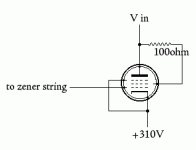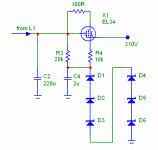This is the circuit (http://headwize.com/images/barbour3.gif). It's the supply for Barbour's "brute force in a line stage" as originally published in glass audio?
anyway in the headwize article (http://headwize.com/projects/showfile.php?file=barbour_prj.htm), there was addendum of using an EL34 instead of an 6AS7. Here's the text:
10/7/98: Changes to power supply schematic (figure 2): R1 restored. Also an EL34 with a 100 ohm resistor connecting the plate to the screen can substitute for the 6AS7.
looking at the datasheet, the EL34 is a pentode while the 6AS7 is a dual triode.
I already have an EL34 and my 6.3 secondary is limited to 2A so it would be nice to use the EL34.
Can someone help in figuring out which pin goes to which? Also what is the wattage for this 100ohm resistor?
Thanks for the help
============================
Here's what I came up:
1. after R3, it goes to pin 3 which is the plate.
2. 100ohm resister from plate to pin4 grid2 (can't see any screen on any EL34 datasheet)
3. Vout is from pin 8 which is the cathode
anyway in the headwize article (http://headwize.com/projects/showfile.php?file=barbour_prj.htm), there was addendum of using an EL34 instead of an 6AS7. Here's the text:
10/7/98: Changes to power supply schematic (figure 2): R1 restored. Also an EL34 with a 100 ohm resistor connecting the plate to the screen can substitute for the 6AS7.
looking at the datasheet, the EL34 is a pentode while the 6AS7 is a dual triode.
I already have an EL34 and my 6.3 secondary is limited to 2A so it would be nice to use the EL34.
Can someone help in figuring out which pin goes to which? Also what is the wattage for this 100ohm resistor?
Thanks for the help
============================
Here's what I came up:
1. after R3, it goes to pin 3 which is the plate.
2. 100ohm resister from plate to pin4 grid2 (can't see any screen on any EL34 datasheet)
3. Vout is from pin 8 which is the cathode
Hi Jarthel.
With the 100R resistor you are making the EL34 operate as a triode. So, "V in" goes to the plate of the EL34, 'signal' in goes to grid number 1 and V out comes from the "cathode" of the EL34. It's pretty easy - I just don't know the EL34 pinout out of my heat.
Be sure you wired it right, if in doubt, repost here and we can give more advice.
Erik
With the 100R resistor you are making the EL34 operate as a triode. So, "V in" goes to the plate of the EL34, 'signal' in goes to grid number 1 and V out comes from the "cathode" of the EL34. It's pretty easy - I just don't know the EL34 pinout out of my heat.
Be sure you wired it right, if in doubt, repost here and we can give more advice.
Erik
ErikdeBest said:Hi Jarthel.
With the 100R resistor you are making the EL34 operate as a triode. So, "V in" goes to the plate of the EL34, 'signal' in goes to grid number 1 and V out comes from the "cathode" of the EL34. It's pretty easy - I just don't know the EL34 pinout out of my heat.
Be sure you wired it right, if in doubt, repost here and we can give more advice.
Erik
when you said "signal", I assume you mean the string of zener diodes?
also what happened to the 100 resistor? where is it connected?
ray_moth said:Don't forget the suppressor must be connected to something too, usually the cathode.
could you please explain what is the suppresor?
=============
can someone suggest what wattage would be enough for the 100ohm?
thank you for the help
@jarthel
What would we do with out google?
http://en.wikipedia.org/wiki/Suppressor_grid
www.answers.com/topic/suppressor-grid
1 watt will do fine. 1/2 watt should be okay.
Cheers
Wayne
could you please explain what is the suppresor?
What would we do with out google?
http://en.wikipedia.org/wiki/Suppressor_grid
www.answers.com/topic/suppressor-grid
can someone suggest what wattage would be enough for the 100ohm?
1 watt will do fine. 1/2 watt should be okay.
Cheers
Wayne
cogsncogs said:@jarthel
What would we do with out google?
http://en.wikipedia.org/wiki/Suppressor_grid
www.answers.com/topic/suppressor-grid
1 watt will do fine. 1/2 watt should be okay.
Cheers
Wayne
suppressor is almost a generic word. I wouldn't know I need to use it in combination with "grid" if you didn't tell me
when you said "signal", I assume you mean the string of zener diodes?
Yes. I wouldn't call it signal but reference (V).
Also be sure to connect pin 1 to pin 8, the suppressor grid to the cathode as in the EL34 these are brought out to seperate pins unlike a 6L6 etc.
Wayne
showdown said:I'm sure someone can correct me if I'm wrong, but this is what I'm thinking:
last question: Do I still need R3 (20K 10W) as mentioned in the schematic?
thank you everyone for the help
last question: Do I still need R3 (20K 10W) as mentioned in the schematic?
Yes, absolutely! Otherwise you would have all of your PS current across the zeners which would fry them! The resistor is neeed as you are taking the voltage drop across it as the voltage reference which is applied to the (control) grid.
Wayne
Edit: I was assuming you meant a short for R3. But still you need it as stated because you will need to have current across the resistor/zener diode string.
Firstly, jarthel, I apologise for using jargon, assuming you're familiar with pentodes. Suppressor is an abbreviated name for the suppressor grid, also called Grid 3. It's what makes the difference between tetrode and pentode.
Secondly, can I squeeze a quick question in here, please?
Do you guys believe that the EL34 can actually do the job as a regulator pass tube here, or will it incur too high a voltage drop between plate and cathode?
Secondly, can I squeeze a quick question in here, please?
Do you guys believe that the EL34 can actually do the job as a regulator pass tube here, or will it incur too high a voltage drop between plate and cathode?
ray_moth said:
Secondly, can I squeeze a quick question in here, please?
Do you guys believe that the EL34 can actually do the job as a regulator pass tube here, or will it incur too high a voltage drop between plate and cathode?
thank you asking the question.
I just believed it would work as the article was written by someone vastly more knowledgeable than myself.
If you are trying to sub an EL34 fpr a 6AS7 as a pass tube, one of the first things you want to check is the heater to cathode voltage rating. The 6AS7/6080 has a high filament to cathode breakdown rating - I don't recall the rating for the EL34 being anything special. If you have an isolated filament winding feeding the pass tube, all is well. If not, beware....
Do you guys believe that the EL34 can actually do the job as a regulator pass tube here, or will it incur too high a voltage drop between plate and cathode?
Good point!, with 250VAC giving a maximum raw DC of ~340V there will be only max 30V over the tube, a EL34 can only pass about 20mA at this voltage and then there is no margin for drops in line voltage.
I would recommend a higher voltage from the transformer and to build a better power supply with better regulation using at least a pass tube and a control tube, I have been very successful with a design similar to this http://www.bonavolta.ch/hobby/en/audio/reg_sup.htm#Tubes 1
although I use a 6BM8 with the triode as control tube and the pentode triode coupled as a pass element, I also use gas regulator tubes as reference.
Regards Hans
wrenchone said:If you have an isolated filament winding feeding the pass tube, all is well. If not, beware....
from what I understand, I should not worry if the EL34 has its own secondary and no other tube heater is connected to that secondary. is this correct?
looking at the datasheet, 6AS7 has 300V of heater-cathode voltage limit. While the 6CA7 has 100V limit.
I looked at Phillips and Mullard EL34 datasheet and I can't deduce the heater-cathode boltage.
- Status
- This old topic is closed. If you want to reopen this topic, contact a moderator using the "Report Post" button.
- Home
- Amplifiers
- Tubes / Valves
- EL34 in place of a 6AS7G (used in the supply circuit as a pass tube). how?

